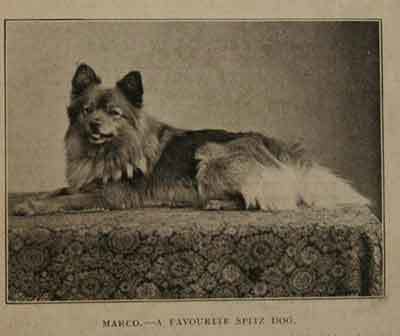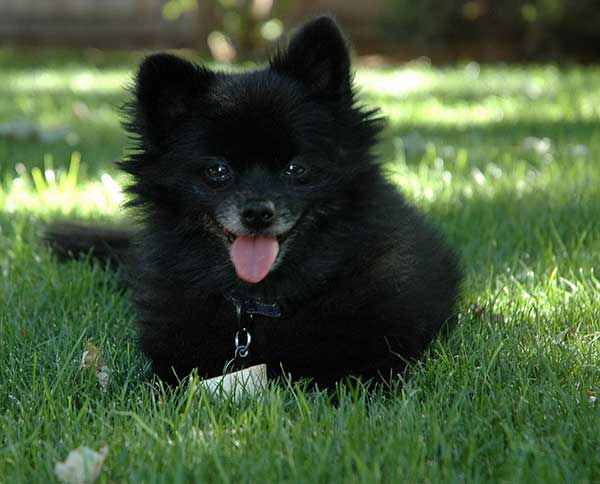The Pomeranian is a descendant of huge sled dog-breeds, albeit in a tiny size, and boasts of a long, illustrious past.
This foxy-faced dog is an active, competent and affectionate entity, capable of performing superbly in agility and obedience competitions alike. We are all quite acquainted with the white and tan poms, but what exactly is a black Pomeranian?
Well, a black pom is a singular representation of one of the varied coat colors prevalent in this breed.
In this article, we will attempt to give you a better understanding of the effects of this black hue, the popularity of black poms, their origin and also, the many myths surrounding the mystical black hue of poms.
Table of Contents
ORIGIN OF THE TOY BLACK POMERANIAN
Pomeranian first came into the picture in the province of Pomerania and descended from the ancient Spitz Breeds prevalent in the far northern countries.
Thanks to breeding efforts, these sled-dogs were developed from the old Spitz dogs and gradually, came to adopt a smaller size. The closest cousins of the Pomeranian are the Schipperke, the Norwegian Elkhound, the Samoyed, the American Eskimo dog, the German Spitz, as well as other Northern members of the Spitz.
Just for you information, Spitz are dogs characterized by wedge-like heads, thick, furry coats, and prick ears. The early poms were rather heavy-built dogs and weighed up to 30 pounds. This is not surprising, considering that they were bred especially to act as working dogs in the snow and sleet.
These early Poms were medium sized and had pure white coats. One question we need to ask here is, what led to the different types of coloring in modern-day poms? Also, how did the black poms come to exist, when they are, in fact, a stark contrast in color to the ancestors of their breed?
At present, only so much information is available to pin point the significant breeding efforts carried out by people. Due to a lack of pertinent record keeping, it is not possible to validate certain details, like for example, the exact origin of the black poms, or their first appearance in history. There is definitely a void in information, specifically with respect to the time when the coloring was first introduced in modern culture.
Fortunately, we do have some data to draw logical conclusion regarding the mysterious appearance of black poms. Our assumption is that since the Pomeranians today are essentially teacup dogs, the Spitz, their ancestor, was probably, at some point in history, bred down in size.
This breeding may have been done using the Spitz as one of the parents, and a smaller, differently colored dog as the other parent. Hence, it’s only obvious that the parent that contributed the small size was also the one that transmitted varied color genes to the next generation poms.
We are yet to uncover the breed of this second parent.
Further Reading: How To Entertain Your Dog When You’re Not At Home
POPULARITY OF THE PURE BLACK POMERANIAN
The conventionally colored Pom has always been popular ever since its development.
[thrive_text_block color=”red” headline=””] Notable people to the likes of theologian, Martin Luther, artist Michelangelo, physicist Isaac Newton and music composer Mozart, had shared their lives with this beloved breed. [/thrive_text_block]Pomeranians of all types of coat colors have been favored by people in the past. This can be attributed to their cute stature and affectionate nature.
Until the eighteenth century, Pomeranians of medium size enjoyed tremendous popularity with the dog enthusiasts.
[thrive_leads id=’7777′]However, all that changed with the start of Queen Victoria’s reign.
During her years as the Queen of England, she is known to have an upwards of 15 different dog breeds. In the later years, she developed a special liking for Pomeranians, which came to her notice first in 1888 en route to Italy.
She particularly adored a sable and red Pomeranian called Marco, who, due to a genetic error, weighed only around 12 pounds. Today, many are of the opinion that this mini pom, Marco, was the flagship dog of small, teacup Pomeranians.
Marco became Queen Victoria’s favorite dog and went on to represent royalty in dog shows and did splendidly in all by winning the honors. Victoria then ended up buying three more Poms during the same trip to Florence. However, Marco remained the apple of her eye.

After Marco, the Queen’s next favorite dog was Gina, a female Pom who, like Marco, emerged a champion at dog shows held all over London.
Victoria’s fondness for Poms can be understood from her last wish, which was that her beloved Pom, called Turi be allowed to spend time with her in her bedside.
[thrive_text_block color=”blue” headline=””]Queen Victoria loved this breed. Thus, she constructed kennels and worked together with scientists and breeders to make the Pom breed even smaller than the 11 pound Pomeranian she had at that time. [/thrive_text_block]Needless to say, she was successful in breeding small sized Poms and the rest is just history.
Today, Queen Victoria is given credit for the teacup Pom breed that we know of today, and all its attractive color variations.
The legacy of teacup poms did not end with the death of Queen Victoria. Her love for the small sized dogs spurred the English dog enthusiasts and breeders to start breeding smaller sized Poms.
From 1900 to 1930s, Poms experienced a tremendous surge in popularity and often had the most number of entries at dog shows, with the Crufts dog show being a prominent event. It was during this era that the breed’s standard size and appearance was determined, with the size down to a few pounds and the coat attaining its characteristic dense frills.
By this time, a considerable variation in coat colors was also available. Earlier, the Poms used to be either white, blue, chocolate or black, but after an orange Pom winning dog shows in 1920, the spectrum of plausible coat colors became wider.
In 1900, after the American Kennel Club recognized the breed, Poms quickly grew in the popularity in U.S as well. In the next fifty years, Poms became one of the most popular breeds in America and today they hold the status quo of the 14th most popular dog amongst 155 other breeds.

SIZE Of THE PURE BLACK POMERANIAN
Black Pomeranians have forever been small sized dogs. Even now, they reach a maximum height of 12 inches when fully grown, and a weight ranging from 3 to 7 pounds. Yet their small size doesn’t imply a deficiency of desirable features innate to their large, white ancestors.
Few black poms have been reported of having puppies that grow up to be large, with a weight of almost 14 pounds. Regardless of their color and size, these dogs are excellent companions to families with children.
HOW TO IDENTIFY A TRUE BLACK TEACUP POMERANIAN?
Many a time, novice dog owners, dog enthusiasts and even a few inexperienced breeders get confused over the definition and identifying characteristics of a true black Pom dog. Many people incorrectly assume poms to be black when in fact, they are not, at least from the technical point of view.
A true black Pomeranian dog is, in essence, completely black, with not an iota of differential pigmentation. In addition to a black colored coat, these dogs flaunt black coloration on their skin as well. As a result, their lips, paw pads, nose and eye rims, all carry a distinctive black hue.
[thrive_text_block color=”note” headline=””]So, you know that Pom dog in the pet store is a true black one when it has a uniform black coloration on its body. It’s almost like someone has painted them black from face to tail. [/thrive_text_block]
Now that you know what a true black pom is, we’ll bust out all the myths and misnomers that surround the black pigmentation of poms.
Myth #1:
[thrive_text_block color=”blue” headline=””] A Pomeranian with a black body and tan paws can be touted as a true black Pom.
As explained before, any Pom with a touch of a different color at any part of its body is a deviation from Poms with uniformity with respect to that particular coloration. It doesn’t matter whether the disparity in coloration is restricted to a small area or is evident to a greater degree. Thus, a Pomeranian with fully black coat and tan paw pads should be identified as a black and tan Pomeranian.[/thrive_text_block]
Myth #2:
[thrive_text_block color=”blue” headline=””]Pomeranians with a black body and a single spot of white on the chest can be called black Poms.
This one here is another misnomer. Although black bodied Poms with a touch of white here and there are quite unusual in occurrence, that doesn’t mean they fit the definition of a pure black Pom.
It would be more accurate to define these dogs as a black mis-mark or, maybe a black Pom with white marking. In case, the dog carries the white mark as a puppy (i.e black and white Pomeranian puppies) and later grows on to lose that touch of white, thereby attaining a fully black body, he should be registered, preferably, as a black mis-mark who became a true black as an adult. [/thrive_text_block]
Myth #3:
[thrive_text_block color=”blue” headline=””] Black bodies Poms with a dash of white and tan colors are unusual to find and rather a genetic fault
Pomeranians with a complete black coat bearing a spot or two of white and tan are best defined as tri-colored Poms.
Most people casually refers to these dogs as black Poms with a genetic aberration or simply black Poms, but this definition is not a correct one. Although black would be the main color of such a Pom, he cannot be regarded as a true-black by any logic.[/thrive_text_block]
Myth #4:
[thrive_text_block color=”blue” headline=””]
There is no difference between a blackish Pom and a true black Pom.
Wrong. A Pom that appears to be black is not really a true black dog. His dark gray appearance is the result of his coat, which is gray with a uniform black coloration only on the tips of the hair. So, although he may resemble a slightly lighter version of a true black dog, his coat lacks the solid black color. Thus, such a dog should never be confused with black Pomeranians.
[/thrive_text_block]Myth #5:
[thrive_text_block color=”blue” headline=””]Black bodied Poms that appear to be a lighter shade in sunlight are really true black dogs and this change in color is quite normal.
The Pomeranian in question here is a blue dog. This one is another Pom that’s incorrectly dubbed as black. Their coat has the color of a diluted black. While the coat may very well look black in dim lighting, the nose and rest of the body parts shine an unmistakable blue hue in bright sunlight. This myth has mainly developed due to the ignorance of people about the presence of a blue coloration in Poms. After all, blue is quite a rare color in these dogs. [/thrive_text_block]
Further Reading: Choosing The Best Multivitamin For Dogs
ANOMALIES IN COAT COLOR
Color change is of common occurrence in dogs. Many puppies are born with a certain color, only to change it phenomenally by the time adulthood comes.
It is not unusual for dogs to experience a total change over from puppy fur to adult coat while going through the Puppy Uglies.
During the Puppy Uglies, many puppies experience a dramatic change in coloration. However, if their lips, nose and eye rims are black, they will most likely not undergo a change from the solid black color.
Such puppies can be truly termed as true black Poms.
The frequent occurrence of change in coat color can be determined from the fact that breeders are permitted to change color almost 7 times during an AKC registration. Majority of this color change is completed between the time of birth to eight weeks.
Many inexperienced dog owners spend oodles on purchasing a Pom of their color choice, only to see it acquire secondary colorations in the first 8 weeks. Hence, it is advisable to make assumptions on the coat color only after two months have passed from the time of the puppy’s birth. Changes are less drastic as the puppy matures.
APPEARANCE
With their brazen black coat, small stature and piercing, almond-shaped eyes, black pomeranians quite stand out from the rest of the dogs.
While some people describe their faces as fox-like, many others think that a cute, baby-doll look would be a better description. The most striking feature in their overall appearance is the extent to which the coloration has spread in the body. Everything, right from the paw pads and eye rims, to the nose and lips are colored black. Even their plumed tail oozes the night black shade as it fans out over the back.
Black poms are all small dogs. Yet, in their head, they are much larger than their actual size. This, unfortunately makes them difficult to socialize and causes them to initiate fights with larger dogs.
Poms have a rather loud bark, which is quite a surprise, given their size. They also make excellent watchdogs but they often don’t know when to stop barking. Thus, it would be a good idea to train them so that they learn to stop barking on command.
Pomeranians are available in a huge variety of colors, with red, white, orange, cream, blue, black and brown being the most common ones.
Rarely, you may come across as a white Pomeranian with differential color markings. A black and tan Pom and an orange and sable one are also pretty hard to fine.
The Pom has a luxuriant double coat that stands out from the body. While it looks like it would incur a great deal of care, regular brushing is basically all it needs.
GROOMING NEEDS OF A BLACK POM
One of the best things about Pom dogs is that they are available in almost any color or pattern that you can possibly think of in dogs. These include blue, chocolate, cream, orange, red, sable, white, orange sable, cream sable, chocolate and tan, blue and tan, black and tan and brindle (base color of gold, orange, or red with striking black cross-stripes). White Poms having patches of other colors are referred to as “parti-colored”.
The Pomeranian’s pride is his dense, double coat with an underlying undercoat of soft, fluffy and thick hair, as well as an overlying layer of long, shiny and straight hair that is rough to touch. There is a fluff of long hair around the neck and chest forming the frill and enhancing the appearance of the Pom.
[thrive_text_block color=”red” headline=””] Poms are moderate shedders. Males generally shed once a year. Unspayed females too shed their undercoats but only after delivering a litter, and whenever they are stressed out.[/thrive_text_block]
When it comes to black Poms, the grooming needs are slightly different. This is essentially because of the type of debris that occasionally shows up on the dog. For instance, dirt and darker elements have a tendency to show up on a white or cream coat more, while lint as well as lighter elements show up more frequently on a dark colored Pom.
Hence, you may have to schedule the grooming and brushing routine in accordance with the activity of the dog, as well as the environment, in which they spend their day in.
[thrive_text_block color=”note” headline=””] So, to summarize, if your black Pom is overly active and engages in a lot of play outdoors, you will have to groom him more than often.[/thrive_text_block]
With regards to shedding, it’s important to note that Poms of varying colors shed the same amount. Then again, your black Pomeranian’s shedded hair will tend to stand out on light colored rugs, flooring and furniture. Apart from this fact, there are no differences. Poms of all colors have a double coat, shed moderately and are susceptible to tangles.
Further Reading: What Is The Best Brush For Shedding Dogs? (Top 15)
A NOTE ABOUT OWNING A PURE BLACK POMERANIAN PUPPY
Pomeranians are usually purchased by people without gaining first a clear understanding of all that goes into their maintenance.
There are so many black Pomeranian puppies in need of fostering and care. If you are interested in owning a Pom of a specific color, say a black and white Pomeranian, then it’s advisable to adopt/purchase Poms that are older than 2 months. That way, you will be able to vouch for the constancy of coat color.
In case, you don’t find a rescue center for your area on the internet, you can always contact the local breed or the national breed club for information.
Black Pomeranian puppies adoption is best done from recommended and licensed breeders, who take care to breed dogs carefully to eliminate genetic disorders.
[thrive_text_block color=”note” headline=””]All in all, a black Pomeranian has all the desirable traits of its breed and comes in the same size as its differently colored conspecifics. The only notable differences are the coat color and of course, the genetic makeup. [/thrive_text_block]




